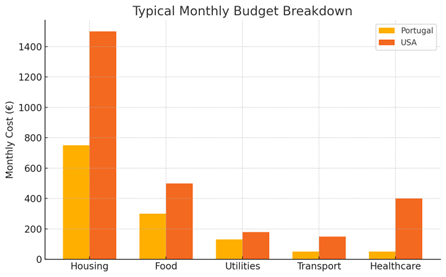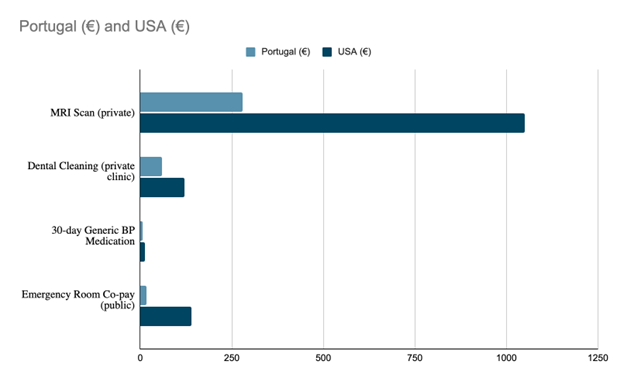The cost of living in Portugal is approximately one-third lower than in the U.S. Groceries cost roughly 39% less, rent about 41% less, and eating out around 38% less. In Lisbon, one person’s monthly bills (rent, food, transport, utilities) total about €800–€1,200 (≈$870–$1,300), while in New York City, they’d be closer to €2,100–€3,300 (≈$2,280–$3,580).

Portugal is generally more affordable for everyday essentials. The chart above provides a clear comparison of typical monthly expenses between Portugal and the USA. In this article, we’ll explore how much everyday life really costs in Portugal and the USA to understand which country offers more affordable conditions for daily living.
Housing Costs in Portugal vs. the USA
Housing is where the cost difference between the two countries is the most noticeable, due to several factors:
● Supply and demand. Portugal’s cities are smaller and less populated than America’s major hubs, so competition is lower. Even in Lisbon, options exist outside the compact historic center, keeping rents manageable. By contrast, the tight housing inventory in New York, San Francisco, and Boston is extremely expensive.
● Regulation and zoning. Portugal lets builders build mid-rise blocks with homes, shops, and cafés in one place. Permits come quickly, so more housing is added. In many U.S. cities, strict zoning rules slow down projects, limit where new homes can be built, and drive up prices.
● Wage alignment. People in Portugal earn less than workers in the U.S., so landlords keep rents lower to match the local wage. In the U.S., higher wages, strong corporate demand, and the presence of many well-paid tech and finance workers contribute to rising rents.
● Mortgage and financing rules. Portuguese banks lend carefully. They cap what buyers can borrow and give long fixed-rate mortgages, making homes less tempting for quick flip deals. In the U.S., buyers often get easier, riskier loans, which helps prices climb faster.
● Ownership costs. Property taxes, homeowners’ insurance, and maintenance fees are generally lower in Portugal. Portugal’s mild weather keeps energy bills low. Thick stone walls help homes stay cool or warm without much extra power. In many parts of the U.S., extreme heat or cold forces families to spend more.
● Lifestyle choices. Getting around Portugal by public transport is easy and affordable, which directly influences how people organize their daily lives. Thanks to reliable buses, trains, and walkable city centers, many residents prefer living in compact apartments near their workplaces, avoiding the need for a personal car. In contrast, cities and towns in the U.S. are largely built around driving. Most people opt for larger single-family homes in the suburbs and rely on cars for commuting, which adds significantly to their monthly expenses.
In Lisbon’s city center, a one-bedroom apartment rents for about €1,200–€1,500 (≈$1,300–$1,650) per month. Outside Lisbon or in smaller cities, such as Porto and Faro, rents typically fall to €800–€1,000 (≈$870–$1,100). By contrast, a similar apartment in major US urban centers typically costs $2,800 to $3,500 or more.
Buying property is also cheaper. In prime areas of Lisbon, prices are about €4,000–€6,000 (≈$4,350–$6,500) per m², while major US cities often exceed $10,000–$14,000 per m². Mortgage rates also differ: recently, US mortgage rates have been in the 6–7% range, while in Portugal they have typically been in the 3–4% range.
Based on the data above, it’s clear that average rent in Portugal is significantly lower than in the USA, and overall housing costs — whether renting or owning — tend to be more affordable in Portugal. This often leaves Americans seeking flexible financial solutions when faced with sudden housing-related expenses. Turning to an online provider of small personal loans has become a common way to cover deposits, repairs, or urgent rental payments.
Dining Out, Groceries, and Food Prices
Daily food is cheaper in Portugal. For example, a small “basket” of common items might cost €200–€300/month in Portugal (≈ $234–$351/month), while in the U.S., a similar basket runs closer to $400–$500.
| Item (unit) | Portugal Price | U.S. Price |
| Milk (1 L) | €0.94 (≈ $1.10) | $1.10 |
| Bread (500g) | €1.38 (≈ $1.61) | $3.74 |
| Eggs (dozen) | €2.68 (≈ $3.14) | $4.39 |
| Apples (1 kg) | €1.94 (≈ $2.27) | $5.45 |
| Chicken fillets (1 kg) | €6.66 (≈ $7.80) | $12.57 |
| Domestic beer (0.5L) | €1.11 (≈ $1.30) | $2.02 |
| Wine (mid-range bottle) | €4.99 (≈ $5.83) | $15.48 |
Imported or branded goods can be more expensive in Portugal, but local produce, bread, meat, and dairy are generally very affordable. Also, country renowned for its affordable fruit, vegetables, and seafood.
Eating in Portugal is also more budget-friendly. Local cafés and restaurants offer daily menus and inexpensive coffee. A “meal deal” at a pastry café, like a sandwich with coffee, can cost only about €5–€7 (≈ $5.85–$8.19). A basic café lunch, including wine, might be €7–€12 (≈ $8.19–$14.04).
Inexpensive restaurants often serve a full meal for one person under €11 (≈ $12.87). For a mid-range dining experience, expect to pay about €35–€45 (≈ $40.95–$52.65) for a three-course dinner for two. That’s roughly half the price of a similar meal in the U.S., where $70–$90 is more typical.
Transportation and Utilities
Again, getting around is generally cheaper in Portugal. Public transit is excellent and affordable. In Lisbon, it costs about €40–€50 monthly (≈ $47–$59). However, major U.S. cities often charge $75–$130 monthly for transit passes. For example, Washington,, D.C. has monthly Metro passes costing nearly $90.
Single-ride tickets are also lower, around €1.50–€2 in Lisbon (≈ $1.75–$2.34). If you drive, fuel is more expensive per liter in Portugal — about €1.70/L (≈ $7.50/gallon) — compared to the U.S., where it’s around $0.82/gallon. However, many Portuguese cities are smaller, so people own cars less often. Parking fees in U.S. cities can also be much higher.
Taxis and ride‑shares are inexpensive. A city taxi starts at only a few euros (≈ $3–$5), and Uber‑type services cost much less than U.S. rates. Even tolls and inter‑city train tickets cost a fraction of similar U.S. distances.
Utilities like electricity, heating, and water are generally modest in Portugal. Let’s compare them, too:
| Expense (per month) | Portugal | USA |
| Electricity + Gas (85 m²) | 110 ≈ $129 | €170 ≈ $198 |
| Water & Garbage | 25 ≈ $29 | €40 ≈ $47 |
| High-speed Internet | 36 ≈ $42 | €65 ≈ $76 |
| Mobile Plan (10 GB) | 12 ≈ $14 | €45 ≈ $52 |
| Basic Streaming Service | 8 ≈ $9 | €13 ≈ $15 |
While Americans may pay less for gas, most transportation and utility costs are still cheaper or comparable in Portugal.
Healthcare
Portugal’s affordability in healthcare is particularly impressive. The country has a public healthcare system (SNS) that provides the most basic services to residents at little or no direct cost. Even without insurance, patients usually pay only a small fee for a doctor’s visit or prescription.
Many expats also choose private health insurance plans to shorten wait times, which typically cost around €50–€100 per month (≈ $59–$117). In the U.S., private health insurance for a similar person can easily cost $400–$800 per month or more, and individual visits (without insurance) are usually $100–$200 or higher.
Nevertheless, Portugal’s healthcare among the best in the world. The chart below shows how much more affordable key medical services are in Portugal compared to the U.S.

The U.S. spends about 18% of its GDP on healthcare—roughly twice as high as Portugal’s 9%—yet Portugal still provides universal access to medical services.
Education and Childcare
Thanks to heavily subsidized education and childcare, Portugal is much more affordable for families. Public primary and secondary schools are free for residents, and students only pay small fees for books and materials.
International or private schools, which expats mostly choose, are not as cheap. They range from €6,000–€15,000 per year (≈ $7,020–$17,550) for one child, depending on the school’s reputation. But even that is low compared to the U.S., where private K–12 schooling typically costs $10,000–$25,000+ per year.
College tuition is also far lower. In Portugal, public university tuition is just a few thousand euros per year—typically €3,000–€4,000 (≈ $3,510–$4,680)—but U.S. colleges can run $11,700–$58,500 annually.
Portugal keeps childcare costs low. Preschool and daycare are becoming free for children under 3, so many families pay nothing at all. Private creches cost around €200–€300 per month (≈ $234–$351). In the U.S., daycare usually costs $800–$1,500 per child per month.
Parents in Portugal also enjoy about four months of paid leave for mothers and several weeks for fathers, while U.S. federal leave is 12 weeks unpaid.
Taxes and Mandatory Payments
Portugal adds a 23% value-added tax to most purchases, with rates of 13% in restaurants and 6% on basic food. The rate is high but helps fund free healthcare, public schools, and pensions. Income tax can reach 48%, yet many expats qualify for the Non-Habitual Resident (NHR) scheme and pay far less for a period of ten years.
In the United States, the top federal rate is about 37%. Most workers also owe state tax and 7.65% in Social Security and Medicare payroll deductions. Because public coverage is limited, Americans spend much more out of pocket on health insurance and college.
Entertainment
A movie ticket in Portugal (for a new release) costs around €8–€9 (≈ $9.36–$10.53), whereas in the U.S. a movie ticket typically costs about $17. Live music, museums, and other events charge lower entrance fees. For instance, many Portuguese museums have entry fees of €5–€10 (≈ $5.85–$11.70) or offer free access days, while U.S. museums usually charge $17–$29 or more.
Cheapest Places to Live in Portugal
Some Portuguese cities and regions offer exceptionally low costs:
● Braga (North) – A university city with history and culture. You can rent a one-bedroom apartment downtown for about €470 (≈ $550) a month, roughly 30% less than the national average.
● Coimbra – Home to an ancient university. The average city-center 1BR is about €500 (≈ $585), roughly 25% under the Portugal average. Outside the center, rents fall to ~€400 (≈ $470).
● Aveiro – A scenic canal town. City-center rent for one bedroom averages around €550 (≈ $645) and drops to €400 (≈ $470) outside downtown.
● Leiria – A central inland city. The average 1BR rent in Leiria’s center is only €450 (≈ $525), with outside rates near €350 (≈ $410).
Families can live well on a modest budget. For example, a single person living in Braga or Leiria might need only €700–€900 (≈ $820–$1,055) per month for basic expenses (excluding rent). It’s an attractive option for retirees or remote workers looking to maximize quality of life on a budget.
Is Portugal Cheaper than the US?
The numbers above make it clear: yes, Portugal is cheaper overall. Almost every primary expense is lower. Housing in Lisbon can cost significantly less than a comparable US apartment. Groceries and transportation run roughly 30–50% lower than U.S. norms. Even when a particular item is more expensive in Europe, overall spending still favors Portugal.
Of course, we should also consider salaries (which are lower in Portugal), taxes, and service differences. But in terms of raw living costs, Portugal’s advantages are unmistakable.
Financial Support for People
Before deciding and distributing costs, you must be sure there are ways to get help if your finances are tight. Both countries have social safety nets, but Portugal’s are generally more modest. In the U.S., federal programs, such as Social Security, Medicare/Medicaid, and unemployment insurance, are supportive, too.
Portugal offers unemployment benefits, about 65–75% of the previous salary for limited months, pensions through social security, and family subsidies. Child tax credits and other EU co-financed programs also help families.
For short-term cash needs, people can use lending services. Several fintech and credit websites allow qualified applicants to access online loans of up to a few thousand euros or dollars. These loans can help cover relocation costs, deposits, or other urgent expenses.
Both countries have credit card and mortgage markets. Portuguese banks offer personal loans and mortgages at lower interest rates, and Americans pay more on unsecured debt but may access larger home mortgages. Both countries also offer student loans, but U.S. students face much higher tuition.
Final Thoughts
Is Portugal cheaper than the US? For most expats comparing the cost of living, the answer is yes. Portugal is kinder to your wallet. Rent, groceries, bills, buses, healthcare, and daycare cost much less than in the U.S. Most people pay with cash or debit, so debt stays small. While salaries in the U.S. are generally higher, zoning limits, long commutes, large homes, and expensive private insurance often absorb much of that income.
If you’re looking for lower daily expenses and reliable public services, Portugal clearly wins. But if higher paychecks and a broader job market are your priority, life in the U.S. might suit you better. Ultimately, it depends on what lifestyle matters most to you.
About the Author
Kevin Wood is an expert finance writer with extensive experience in personal finance. He has authored hundreds of articles on loans, credit cards, and financial literacy to help people manage their money wisely.













That was the best accurate evaluation between the US and Portugal. I would love to see one that compares Canada, eg. British Columbia and Ontario. Well done.
By Lorraine Ingebrigtson from Algarve on 30 Jul 2025, 16:41